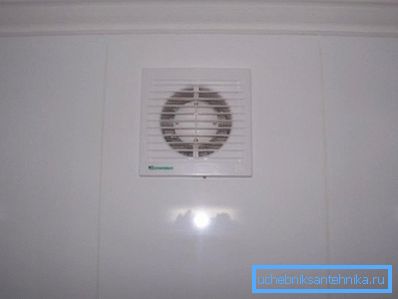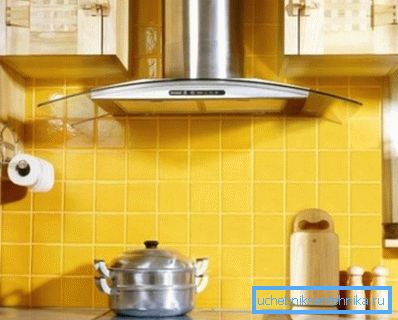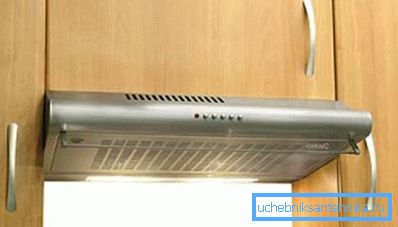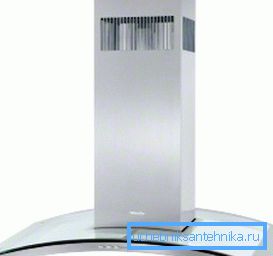Exhaust ventilation in the kitchen and its features
In the kitchen, as you know, special conditions of the microclimate, so this room needs a reinforced hood. Otherwise, high humidity and high temperature will lead to the formation of condensation on the windows, and the fat deposited on the wallpaper and furniture will spoil the appearance of the room. In this article we will look at what constitutes exhaust ventilation in the kitchen and its features.

Why in the kitchen exhaust ventilation
In addition to the main tasks that are voiced above, exhaust ventilation performs a number of other functions:
- Prevents the spread of food smells and burning to other rooms during cooking.
- Eliminates the excess gas that is released during the operation of gas burners, and thus ensures the safety of residents.
- Normalizes the temperature and humidity in the room due to the flow of fresh air.
- Often the hood is an attractive element of the interior, so exhaust ventilation for more than a dozen years has been an indispensable kitchen attribute.
Types of exhaust ventilation
Exhaust kitchen ventilation can be divided into two types:
- Common;
- Local.
Next, we look at the features of each type of ventilation system.

Overall
For the device general exhaust ventilation using a special fan, which is installed in the vent hole. Perfect exhaust fan models are equipped with humidity sensors and operate automatically. Their cheaper counterparts are turned on manually.
Installing such a fan with your own hands is not at all difficult. As a rule, the device is simply superimposed on the wall and fixed with screws. After that, you need to connect the fan to the electricity and the switch.
The main thing is that the diameter of the hole coincides with the diameter of the fan nozzle.
The following sizes are standard:
- 100 mm;
- 125 mm;
- 150 mm.
Note! The fan is installed after all the finishing work.

Local
This ventilation system involves the installation of a special exhaust device (hood) in the cooking zone. Most often, the hood is installed directly above the stove at a height of 700 mm.
Ventilation in the kitchen with the hood more effectively cope with the elimination of odors and fumes released during cooking. According to the method of installation and design, hoods are of several types:
| Wall mounted | The device is installed above the slab and is attached to the wall. Connection of a kitchen hood to ventilation is carried out with the help of branch pipes and a corrugated pipe. |
| Suspended | As a rule, are attached to the cabinet installed above the stove. The method of connection to the ventilation is the same. |
| Embedded | They differ from previous designs in that they are not suspended, but are built into the cabinet located above the stove. Their advantage is the attractive design of hanging cabinets. |
| Recirculating | Unlike all the above devices, this hood is not connected to the ventilation duct. She has a filter that cleans the air, and then returns it back. |

I must say that the hoods for outdoor installation can have a very different design, both classic dome and ultramodern. Accordingly, the price of products may also be different.
However, they all have the same device and consist of the following elements:
- The case in which the exhaust umbrella is installed. The design of the device depends on the case.
- The engine - as a rule, power ranges from 50 to 200 watts. The speed of work varies in the aisles of 1500 - 2000 revolutions per minute. Power consumption of the device and performance depend on the power of the hood.
- Air duct - can be square or round. The optimum diameter is 150 mm and more. Most often, galvanized steel is used as a material for exhaust pipes.
- Decorative casing - which hides the exhaust pipe.
I must say that not always the axis of the exhaust pipe coincides with the axis of the ventilation channel. In this case, the connection is carried out using a corrugated aluminum or steel pipe. The latter is able to withstand temperatures up to 900 degrees.
Note! The fewer knees the duct has, the more efficiently the hood works. Its rotation of 90 degrees reduces the performance of the device by 10 percent.
To hide such a pipe, you should use a duct, since it is unlikely to hide a duct of such diameter in the wall. The easiest way to make a ventilation box for the hood in the kitchen of plasterboard. In this case, in the box, you can perform lighting for technological and decorative lighting.
The corrugated pipe is connected to the ventilation duct with a clamp. Thus, to perform self-installation of the hood under the power of every home craftsman. In addition, complete with the device, as a rule, there is a detailed instruction for its installation.
Note! Before connecting the kitchen hood to ventilation, you must check the traction in the system. Its absence may indicate that the ventilation duct is blocked. To fix the problem, you need to seek help from specialists.

Separately, it should be said about the recycling system, the principle of which is as follows:
- Like conventional hoods, this device sucks air with rotating blades.
- At the entrance to the housing, contaminated air masses pass through the first grease filter, which, in addition to the fat, retains soot, soot particles, dust and other debris.
- Then, under pressure, air enters the fine filter, which eliminates unpleasant odors, small particles of soot, etc. This filter is a cartridge filled with coal.
- After passing through the two filters, the purified air flows back into the kitchen.
Despite the fact that the recirculation hoods appeared much later than usual, they gained a certain popularity.
Note! The outer and inner surfaces of the hood must be periodically cleaned of grease in order to prolong their life.

Features of the arrangement of lingering ventilation in the kitchen
The device ventilation system in the kitchen means not only the installation of the hood, but also to ensure the flow of air. Most often, for these purposes, use the inlet valve, which compensates for the vacuum of the air environment, which occurs when the hood is turned on.
Of course, air can be leaked from other rooms through door slits. Moreover, this scheme works quite effectively, however, with regard to the kitchen, it has several disadvantages.
A ventilation system using a fresh air or window valve will be more efficient. However, it allows you to independently regulate the flow of fresh air.
Another important point in arranging the ventilation system in the kitchen is the duct material. The main requirement for it is fire safety. Therefore, you can not use plastic pipes.

The best option is galvanized steel, as this duct is not susceptible to corrosion and is fireproof.
Here, perhaps, are all the main nuances of arranging the exhaust ventilation system in the kitchen.
Conclusion
Kitchen exhaust ventilation allows not only to increase the durability of finishes and furniture, but also makes staying in the kitchen while cooking more comfortable and safe. Local ventilation is most effective, i.e. using hoods.
From the video in this article, you can learn some additional information on this topic.